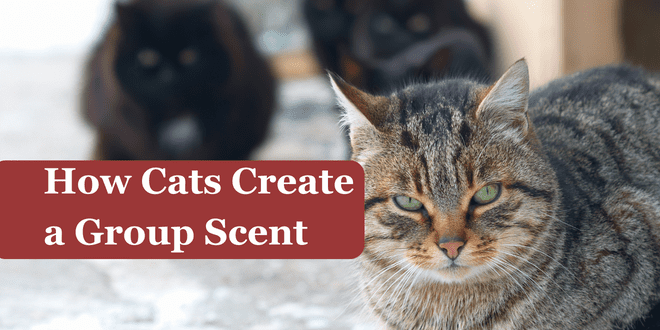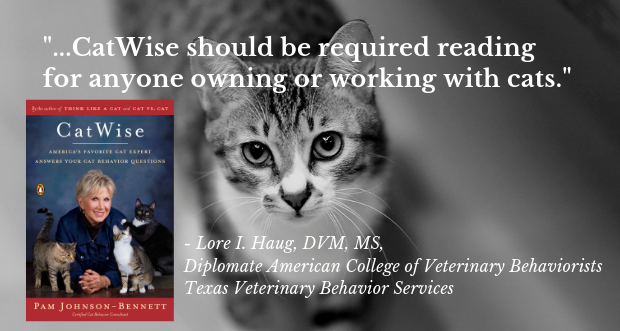
Scent plays a huge role in a cat’s life. To highlight that point, here’s some interesting information. Cats have about 200 million scent receptors in their nostrils and humans have about 5 million. Think about all the scents our noses are missing.
Your cat’s scent-marking and scent-detection capabilities are always working. An environment surrounded with familiar scents is very comforting to a cat and is an important means of identification.
Scent is also used by cats to identify one another. When cats are unfamiliar with each other, their scent-detection ability provides valuable information about the cat who left the scent. It’s so fine-tuned and detailed; the scent mark will tell the “sniffer” information such as the sex, status, reproductive status, and age of the cat. It’s the feline version of leaving a business card.
The Group Scent in a Cat’s World
Scent in a multiple cat environment involves the comfort of creating a group scent. You’ve probably seen this on a daily basis in your home as you watch companion cats rub against each other. You’re even a part of this as your cats rub against you. This is a way of creating a communal scent in addition to being a sign of affection. The group scent is created through allogrooming, head bunting, and body rubbing. These are highly social behaviors that not only create a common scent but also increase the bond between friendly cats. In the case of cats who aren’t so friendly to each other, the group scent-marking keeps things peaceful.
Threats to the Feline Group Scent
If you’ve ever brought one cat to the veterinary clinic while the other cats remained home, you might’ve witnessed hostility on the part of those cats when the feline patient returned home. The cat who returns from the veterinary clinic now smells very threatening. Rather than simply recognizing each other by sight, the scent-oriented cats react to the perceived threat by displaying aggression and fear toward the returning cat. It isn’t until that cat has time to self-groom and take on the familiar scents of the home again that the feline companions begin to relax.
The act of creating and maintaining this group scent provides comfort but is also an aid in survival in an outside cat colony.
Objects in the Cat’s Environment
Your cat doesn’t just scent-mark other companion cats and human family members, he also marks objects in the environment. This is demonstrated by the familiar cheek-rubbing you see your cat do on objects such as chair legs, doors, and anything else within reach.
For many cats, the addition of something foreign in the environment such as a new chair, new carpeting, or new bed can create a revved-up need to adequately mark the unfamiliar-smelling object. For many cats the marking is limited to facial rubbing but if the cat feels threatened or overwhelmed by the strange addition to their territory, he may even resort to spraying.
To make life easier for your cat, especially if you know they have issues with unfamiliar scents in his territory, you can pre-scent objects when first bringing them into the home. Put a sock on your hand and gently rub your cat around the mouth to collect some facial pheromones (scent chemicals) and then rub the sock on the new object. If you have more than one cat, use a clean sock for each cat. Don’t rub one cat with the same sock you used for another cat. If the object is really large, such as a sofa, rub the corners with the scent-baited socks, and then cover the sofa with a sheet or towel that has been used by you. Leave the sheet in place for a few days. This will allow some of the familiar home scents to get onto the sofa.
Other Kinds of Cats Scent
The good thing about scent-marking by facial rubbing, grooming, and flank rubbing is that the scent is undetectable by humans. Cats can pick up every nuance of scents left by each cat but thankfully, our noses are none the wiser. Now, when cats scent-mark using urine – that’s another story altogether. That’s a scent easily detectable by us. When a cat starts urine-marking as opposed to facial rubbing, things in the environment aren’t calm and peaceful. Urine-marking is a high-intensity form of marking. It indicates that the cat may feel threatened or needs to self-soothe by creating a very obvious familiar scent. You may notice an indoor cat spraying near a window if he sees an unfamiliar cat outside. A cat may also spray when a new pet is brought into the home. There are many reasons why a cat may spray so it’s important to figure out the underlying cause so you can address the situation and create security again.
Cats Have Some Special Equipment
Cats have a special organ located in the roof of the mouth. This organ, known as the Jacobson’s Organ or Vomeronasal organ, contains ducts that lead to the mouth and to the nose. This special equipment essentially functions as an analyzer. It’s used primarily for analyzing pheromones (scent chemicals) from other cats, especially the ones found in urine.
Don’t Force the Scent Issue on Your Cat
Some cat parents have been given bad advice about how to use scent to create a peaceful multicat environment during a new cat introduction or when trying to address multicat aggression. I’ve worked with clients who had previously been advised to put one cat’s scent on another cat by either brushing all the cats with the same brush or rubbing one cat with a towel and then rubbing the other cat. This is potentially dangerous and very stressful to the cats. When you put one cat’s scent on another you deny that cat the ability to get away from it. An important and very basic rule in ethical behavior work is to always provide CHOICE to the cat. If a cat feels he has no ability to escape the scent, it may escalate aggression and will probably interfere with the introduction and integration process. You have to go at the cat’s pace. When you push the issue, the cat will typically retreat.
If you’ve ever been to a department store and shopped for perfume, you notice they have paper strips available so you can spritz the perfume on that instead of on your skin. If you spray the perfume on your wrist and you absolutely hate it, you then can’t get away from it.
This is why I recommend using scent methods that allow cats to move away. I use the sock technique during new cat introductions. I rub one cat with a sock and then place the sock in the other cat’s area. This gives the cat the choice of whether to approach and sniff or back away. I use clicker training and reward any positive movement toward the sock, but if the cat decides he isn’t ready to check out the scent, then that’s okay. I go at the cat’s pace.
Respect Your Cat’s Sense of Smell
Your cat has a very sensitive nose and there are so many scents in his environment. Be aware of how invasive certain scents may be, such as highly scented litter, room fresheners, household cleansers, perfumes, etc. Also, be mindful of how important it is to keep the litter box clean due to your cat’s highly sensitive nose. The little things you do (or don’t do) can have a big effect on your cat’s cute, but highly sensitive little nose.
Need More Information?
For more information on cat behavior and training, refer to the books by Pam Johnson-Bennett. Pam’s books are available at bookstores and online. We’ve included links to Amazon here on our website.
If you have a question regarding your cat’s health, please contact your veterinarian. This article is not intended as a replacement for your cat’s veterinary care.





